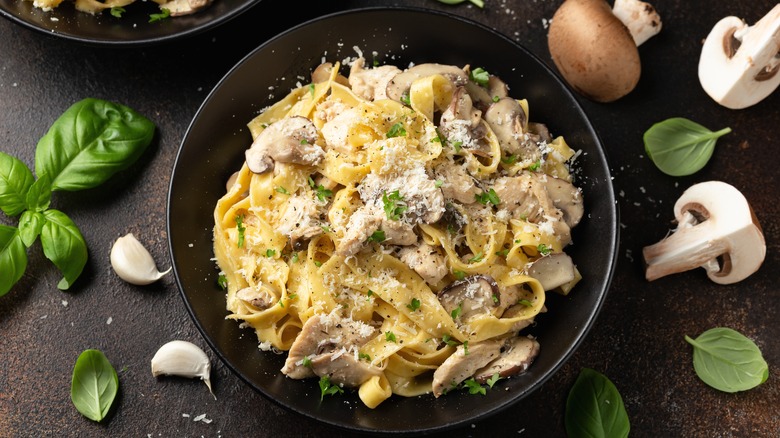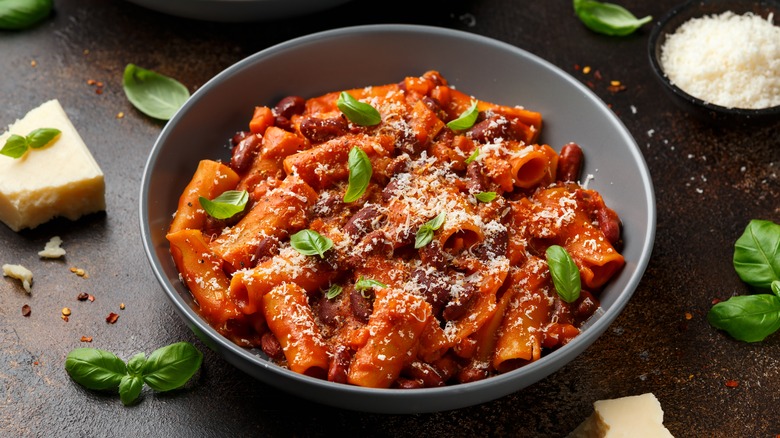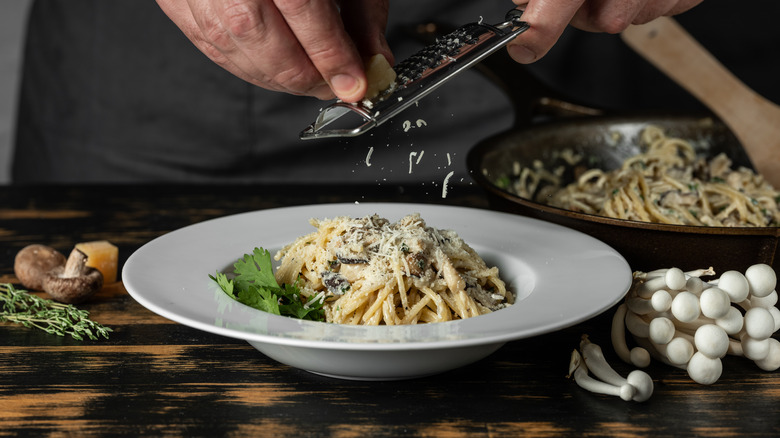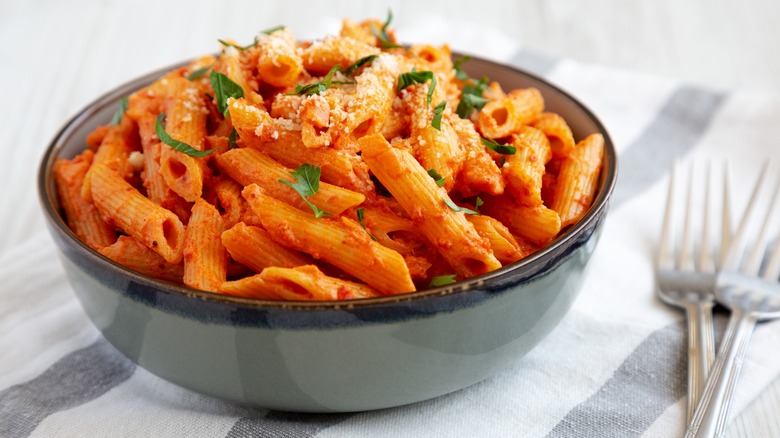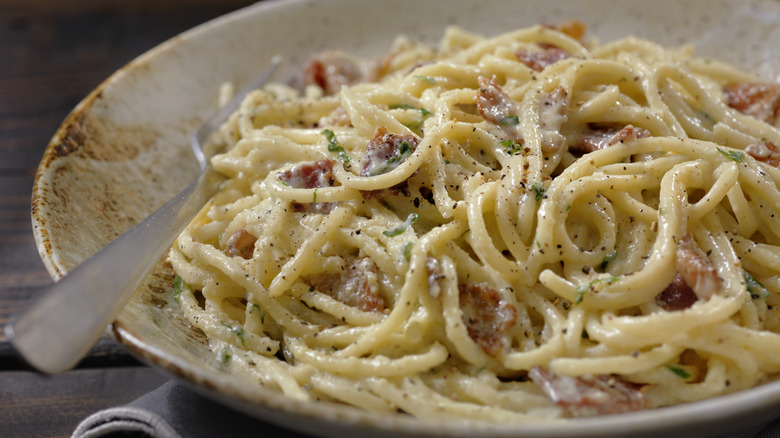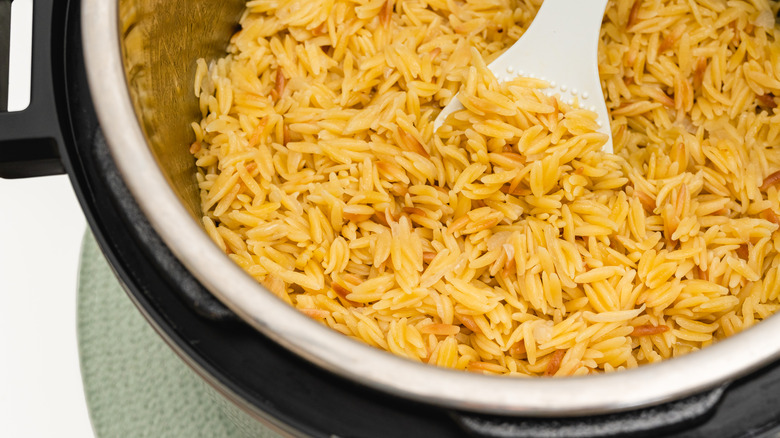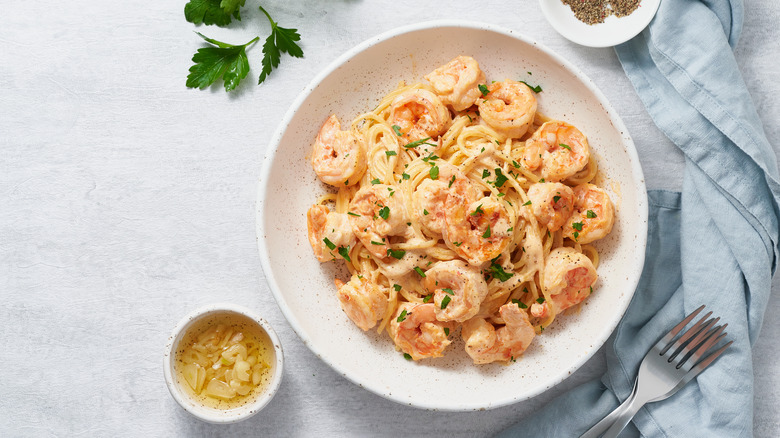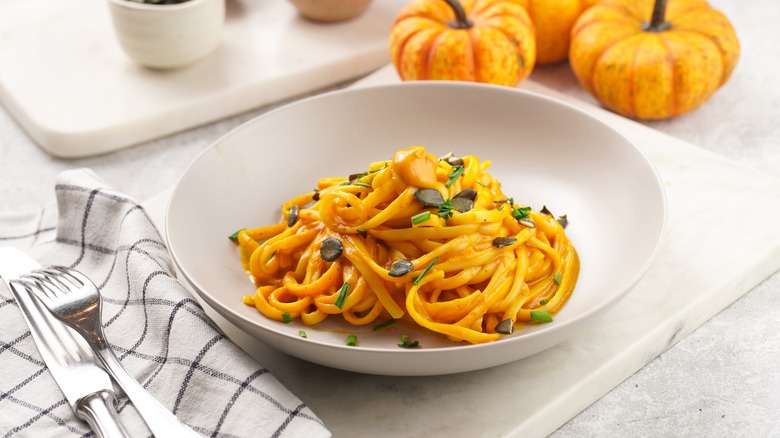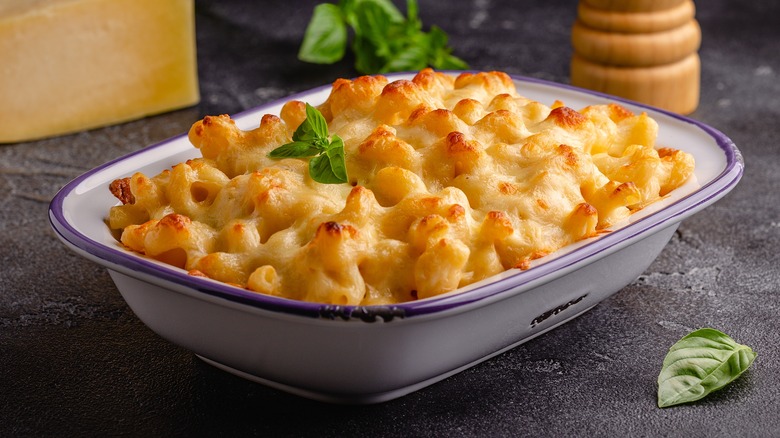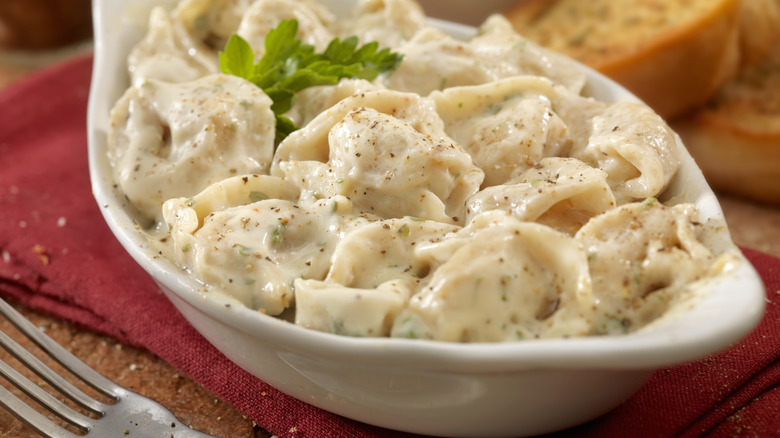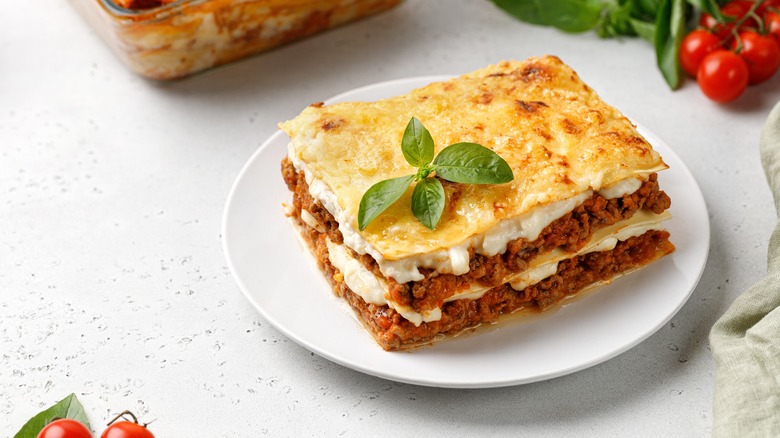12 Canned Soup Hacks For Any Pasta Dish
We may receive a commission on purchases made from links.
Canned soup may well be one of the greatest inventions of all time. Soup has been made for thousands of years, but while it's cost-effective, delicious, and generally simple to make, it can often take hours on the stove. Canned soup, invented in the late 1800s by John T. Dorrance (who later became president of the Campbell's soup company), solved this problem in one fell swoop. By figuring out how to place soup in cans, Dorrance gave the world a meal they could prepare in minutes, while also creating a soup product with concentrated, intense flavor.
This flavor-rich product, however, is not just a dish that can be enjoyed on its own. The concentrated taste of canned soups, and the often creamy texture they have, has allowed them to become a valuable way of adding serious punch to meals without spending an arm and a leg. They're particularly well suited to pasta dishes and sauces, which often benefit from the silky, thick body of canned soup — and many of these soup products are versatile enough to use in a surprising array of noodle-based meals, with some easy-to-execute hacks you may never have thought of.
1. Use canned bean soup for quick pasta e fagioli
Pasta e fagioli is one of the ultimate comfort foods. Translating to "pasta and beans," this soupy dish utilizes two of the long-standing staple ingredients in Italian cuisine, with the beans providing protein, fiber, and an all-around sense of warmth and joy. A standard recipe for pasta e fagioli, however, often requires you to buy multiple cans of beans, tomatoes, and stock. If you're using dried beans, it can also take a significant chunk of your time.
You can sidestep all of these things, however, by simply grabbing a can or two of bean soup, cooking some pasta (ditalini is commonly used, although you can add any short pasta of your choice), and stirring the two together. Bean soups are usually made with a few different types of beans, giving you a load of variety, and because they're often preflavored, you barely have to add anything to the dish. If you can find a bean soup with added ham, all the better: Pasta e fagioli traditionally includes cubed pork as a way to add further flavor and protein. If not, you can just cut up some ham slices and stir them in, using a little chicken or vegetable stock if you like to thin the mixture down slightly.
2. For an ultra-quick meat sauce, try condensed tomato soup
Meat-based pasta sauces often rely on a low, gentle simmering process as a way to extract maximum flavor and cook the tomatoes down until they're mellow and intense. We don't all have time to do that, though, especially at the end of a busy working day. So, in a pinch, just grab a can of tomato soup. All you have to do is brown your meat, as well as any vegetables you're using, before pouring in a full can of condensed tomato soup. Heat everything through, and you're good to go.
The condensed tomato soup will add a burst of instant flavor and will prevent you from having to simmer your sauce extensively. Importantly, this may not work for every type of sauce. If your sauce is a ragù that relies on extended cooking to break down large chunks of meat, then the soup will do nothing to speed this process up, and you'll still end up with tough, undercooked beef or pork. Therefore, it's best suited to sauces where the tomatoes are the star of the show, and where the meat is already small enough to be tender.
3. Use cream of mushroom as a base for spaghetti sauce
Spaghetti sauces can vary enormously in weight and texture, but in our book, they're best when they're creamy. A creamy sauce allows every strand of spaghetti to be coated with deep, full flavor and adds important body to your meal. For those occasions where you don't have cream in your fridge, though, all you need is a can of cream of mushroom soup. This soup can double perfectly as a creamy pasta sauce, and the best part is, it takes barely any effort — you can even just warm it up in the microwave and pour it over your spaghetti if you're so inclined.
Cream of mushroom soup is also a great choice as a base for more complicated sauces, as it has a lightly earthy yet relatively neutral flavor. Upon this, you can build a more developed flavor profile by sautéing any vegetables you like, such as zucchini, eggplant, and (of course) mushrooms, and throwing them in with your sauce. You can add further depth by grating in some parmesan or pecorino cheese or stirring through some crumbled sausage. You don't need to just use this hack for spaghetti, either; it'll work for any pasta of your choosing.
4. For a fresh tomato sauce, combine tomato soup with regular tomatoes
A bright, zesty tomato sauce is a thing of beauty, and its marriage with pasta makes a fantastic simple dish. If you don't have time to make your own marinara sauce, though, or don't have a jar to hand, a couple of cans are your next best bet. Just combine one can of condensed tomato soup with one can of regular or chopped tomatoes. Simmer them together briefly, before pouring over your pasta, or mixing in any extra ingredients of your choice.
Using one part condensed soup and one part canned vegetables allows you to marry instant flavor from the creamy soup with the freshness and tartness from the uncooked tomatoes. This will help to prevent the slightly metallic taste that condensed tomato soup can sometimes have. To add more flavor to your sauce, stir in some dried mixed herbs, allowing them to heat through to distribute evenly through the mixture. Bear in mind, too, that the flavor of raw tomatoes may be too punchy for some, even if they're mixed with soup. Therefore, you may want to cook them down for a while.
5. For a speedy carbonara, use cream of chicken soup
Spaghetti carbonara is one of the more challenging pasta sauces to get right. If your heat is even a little too high, your egg mixture can turn from creamy to solidified, and you end up with a bowl of scrambled egg-covered pasta. Luckily, you can take the risk factor out of your carbonara by skipping the egg entirely and opting for cream of chicken soup. With this easy hack, you add the soup to a few cans of chicken broth and then plunge your uncooked pasta directly into it. Cook the pasta until it's al dente and the mixture has thickened, then throw in some precooked bacon and peas and serve.
The result is a dish that tastes and looks surprisingly similar to spaghetti carbonara, without any eggs in sight. This isn't the traditional way to make the dish, and purists might gasp at the exclusion of such a key ingredient — and it should be mentioned that it won't give you the exact same flavor. It's a great way, though, to combine a few cooking steps in one. If you're vegetarian, you can also use a different cream-based soup, like cream of mushroom.
6. Put a dash of canned soup into a pastina risotto for added creaminess
Risotto isn't just made with rice. It can also be made with smaller pasta shapes, like pastina or orzo, to produce a risotto that can be quicker and often cheaper than using the classic choice of arborio. Because tiny shapes like pastina may not release as much starch as rice grains might, however, there's often a lack of creaminess in these risotti. Additionally, pasta shapes can often have slightly less inherent flavor and nuttiness than rice, leaving your pastina risotto with a taste problem.
The solution? Soup. Even just a dash of condensed soup will give your pastina risotto a shot of flavor while adding extra velvetiness. You can use whichever condensed soup fits best in your meal's flavor balance. While you can still use the more traditional light or heavy cream in pastina risotto, you might find that you have to add a load of extra seasoning, an issue you won't have by using soup. Importantly, though, you should only add a little at a time. If you add too much, you'll end up flooding your tiny pasta pieces, making your risotto into a soup itself — and because pastina and orzo cook so quickly, any attempt to simmer it down will leave you with mush.
7. Shrimp linguine is a breeze with canned clam chowder
Shrimp linguine is one of the most popular pasta dishes out there, but making it requires a host of fresh ingredients that can often be expensive. To make a store-cupboard shrimp linguine, however, you just need some frozen shrimp, some pasta, a can of clam chowder, and a few other choice ingredients. Begin by combining your clam chowder with some milk, grated parmesan, and garlic, and then blend it until smooth. Cook your shrimp, add the blended sauce, and simmer them together for a few minutes before adding your linguine, and serving.
Using clam chowder in this way makes, in essence, a seafood Alfredo sauce, with the creaminess from the condensed soup and dairy ingredients combining with the briny taste of the clams. If you'd prefer to have a slightly chunkier sauce, you don't even have to blend the chowder at all; just mix it with the cheese and milk before pouring it over your shrimp. Bear in mind that you may want to add in some other flavor elements, like parsley and red pepper flakes, to stop the sauce from becoming too dense-tasting.
8. Use a creamy vegetable soup to make a fall pasta dish
Creamy pasta sauces tend to be centered around a few specific vegetables, like tomatoes and mushrooms. However, utilizing some lesser-used veggies, like squash, pumpkin, or carrot, can be a great way to make a pasta sauce that's bursting with nutty, sweet, autumnal flavors.
One of the best ways to do this without having to cook your vegetables for hours is by harnessing the power of a creamy canned vegetable soup. "Boil one pound pasta until it is just shy of al dente (usually about one minute less than the package directions)," Chef Lior Lev Sercarz recommends in his book "Mastering Spice." "Meanwhile, heat the three cups of creamy carrot soup over medium heat until bubbling. Drain the pasta and add it to the soup, tossing until the pasta is evenly coated and al dente." Once you've done that, you simply need to serve things up, topping the pasta with cheese or toasted seeds.
While Sercarz uses carrot soup, any vegetable soup will do — and you can even use a less-creamy canned soup full of chunky vegetables and blend it up to create thickness without the fat content. For added texture, try roasting some chunks of the main vegetable in your soup flavor and stirring it through the pasta at the end.
9. Mac and cheese can be made with condensed cheese soup
Few pasta dishes employ condensed soup as well as mac and cheese does. The dish thrives thanks to its ultra-rich, creamy texture, which is usually supplied by making a béchamel sauce comprised of flour, milk, and cheese. While this isn't the hardest job in the world, it can take a lot of work, and there's always the risk that your sauce will end up lumpy or thin.
There's no such risk if you use canned soup. You simply need to take a can of condensed cheese soup and stir it directly into your mac and cheese dish with some milk and shredded cheese. Then, stir in your cooked pasta, throw some breadcrumbs over the top, and bake until bubbling. Using cheese soup gives your mac and cheese an especially rich, cheesy flavor and stops you from having to add other sources of dairy, making it a great option if you only have one type of cheese to hand. It also gives your dish that nostalgic yellow-orange tone that's essential to many people's enjoyment of the meal.
10. For a speedy Alfredo, use a cream-based soup
Alfredo sauce is one of the more versatile pasta sauces out there, in terms of what you can serve it with. Alfredo can go with pretty much any type of pasta and various proteins and vegetables. Making it, though, can require a lot of fresh dairy, and this can lead to the sauce becoming laden with fat, which may not be ideal for people following certain diets.
A good way around this is to employ a creamy condensed soup. It may come as a surprise, but condensed soups like cream of mushroom are fairly low in fat, compared to regular cream. A ½ cup of Campbell's cream of mushroom, for example, has 7 grams of fat and just 1 gram of saturated fat. Despite this, it doesn't compromise on flavor or texture, making it the perfect option for this velvety sauce. You just add in the soup at the same time you normally would the cream, mixing your cheese and a bit of milk in simultaneously and cooking together until bubbly. Remember that soups like cream of mushroom are versatile, so you can use them as the base for non-mushroom-based Alfredos, like chicken or shrimp.
11. Canned soup gives tuna noodle casserole an upgrade
Perfecting a tuna noodle casserole can make you a hit at potluck dinners, but for such a simple dish, it can take a lot of ingredients. Tuna noodle casserole is usually made with a white sauce, which is made by simmering milk and broth with flour until it has a gravy-like thickness before combining it with your other ingredients and baking everything together. This can add a fair amount of time to your preparation, and if you get your seasoning wrong, your sauce (and your dish) can end up bland.
The simple hack of using canned soup will get around these potential pitfalls seamlessly. Instead of making a white sauce, just combine your ingredients with a can of cream of mushroom soup, adding some milk or broth if everything's a bit thick. Then simply bake as normal. The cream of mushroom soup does an excellent job of binding everything together, partly because it's already thickened with cornstarch and flour, giving it a slight tackiness that adheres the noodles to the tuna. The gentle earthiness of the mushroom flavor also pairs seamlessly with your tuna and can help to slightly temper any brininess from the fish.
12. Replace béchamel in lasagna with cream of mushroom
When people think of lasagna, they usually think of meat — and can often forget about the béchamel sauce that holds it all together. The white béchamel serves both as a glue for the pasta sheets and as a creamy counterpart to the umami, slightly tangy notes of the ragù sauce. Making a lasagna, however, is a lot of work, and the béchamel is often the most annoying part to make — so do yourself a favor and use cream of mushroom soup instead.
You employ cream of mushroom soup in the same way you would your béchamel, by pouring it as a layer on top of your pasta sheets and below your meat sauce. Crucially, cream of mushroom soup is usually much wetter than béchamel, so it might be a good idea to use it sparingly. Alternatively, you can simmer the soup until it reduces and thickens, which will also give it a more intense flavor, or mix some cheese in with it to give it body. Make sure you rest your lasagna before cutting into it too, so that ultra-hot mushroom soup doesn't leak out when you slice it, and instead has a chance to thicken slightly.
